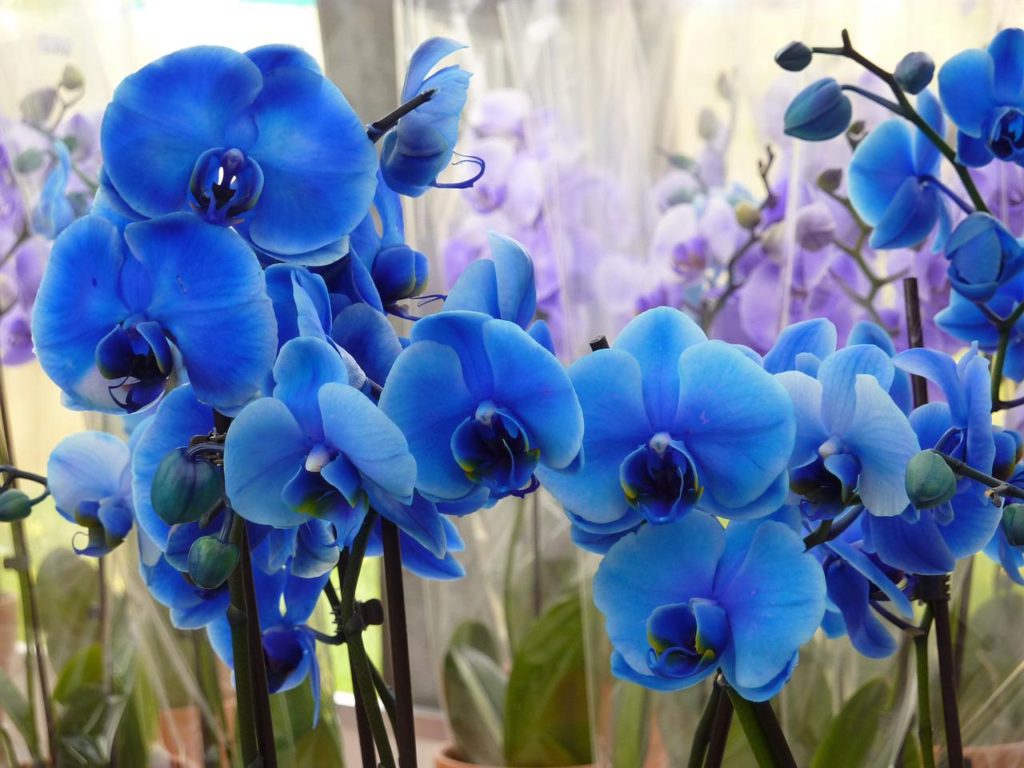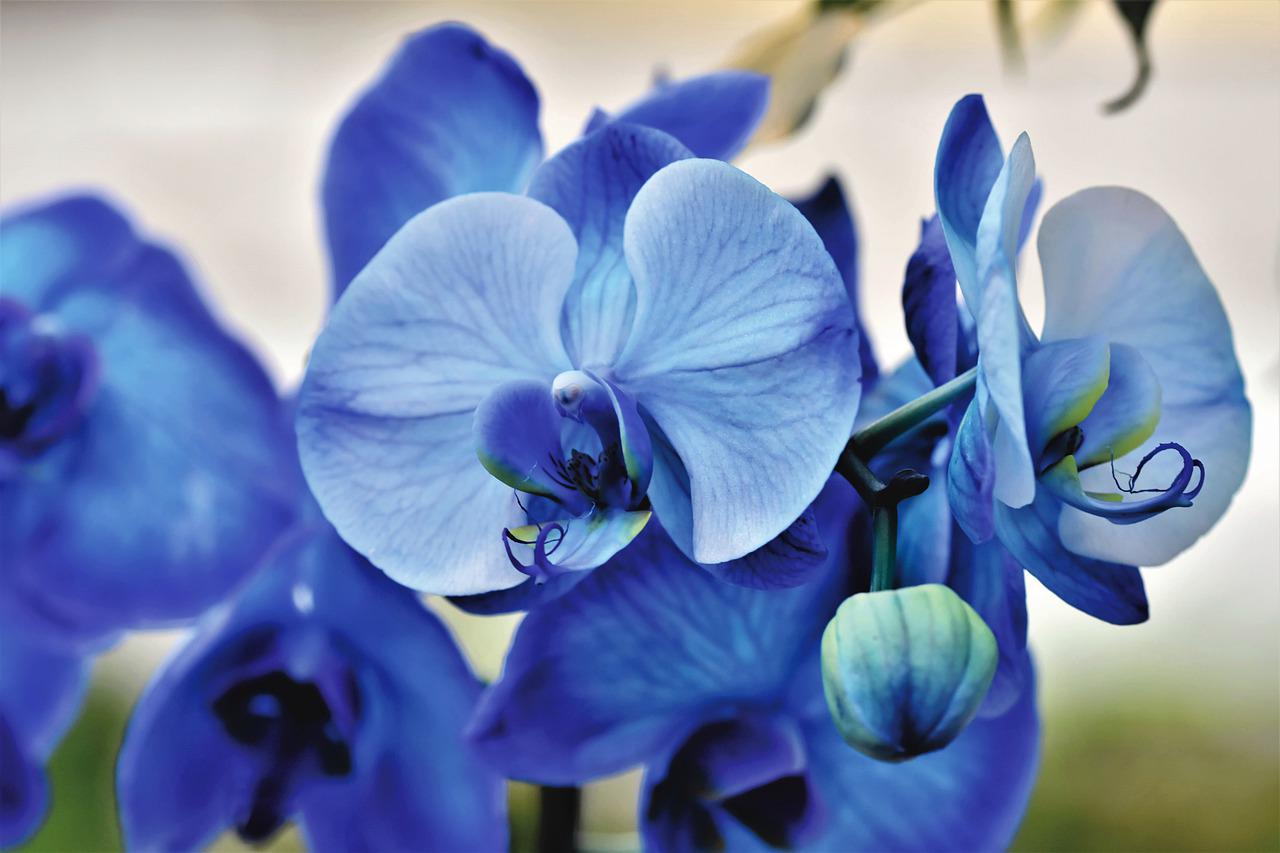Blue orchids are especially popular. The most popular kind of orchid is the blue vanda orchid. However, many are interested in, are blue orchids real. More about this will be discussed in this article.

Are blue orchids real?
Almost all orchids in this shade are fake. Often they take an ordinary phalaenopsis flower, and the blue pigment is added to its base. This is what makes the petals a rich blue hue.
On sale, there are green orchids or white orchids that are painted according to the same principle.
As soon as the flower that is colored falls off, classic snow-white buds will continue to form.
The cost of blue phalaenopsis orchids is slightly higher compared to the usual options. That is why many flower growers become upset when they find out that they bought an ordinary snow-white orchid, which was only artificially dyed. Any blue orchid you come across at your local store can be a dyed blue orchid. The blue phalaenopsis orchid is actually a white orchid with blue dye injected into the plant.
Various kinds of dyes, and blue is no exception, can ruin the whole plant. It will gradually die. Buying a flower is advisable if you plan to admire the plant for only a few months.

Are there real true blue orchids?
Can you get naturally blue orchids? Natural plants in the natural environment are extremely rare. Researchers say that only 10% of all natural flowers have blue or blue buds. Almost all of them are distinguished by a light blue tint. There may also be blue-violet options.
Many people wonder, is blue pink orchid real? In the natural environment, the blue orchid, as already mentioned, is rare. Often, all options on the market are made using blue food coloring. Almost all of them were created by man.

Where can you find the blue orchid?
Almost all flower growers are wondering, where are blue orchids found? The easiest way is to place an order in an online store or go to a flower shop. Rarely, such plants are found in grocery stores. It should be noted that only the available buds will be blue. The new ones will be white.
Natural flowers are even harder to find. The best option would be to buy a flower in special nurseries or laboratories for the development of new flowers. Such options are expensive. This is because they are difficult to grow and propagate.
In the American market, there are entire lists of sellers who sell the blue phalaenopsis orchid. It is safe to buy flowers from them, without deception. In the future, caring for a flower, and breeding it, will be quite difficult. If you are just starting to grow orchids, it is best to choose plain white varieties first.

The meaning of blue orchids
Different versions relate to the meanings of blue phalaenopsis orchids. As you know, such blue flowers symbolize beauty and love. A rare blue orchid can also mean thoughtfulness and charm.
Some believe that they symbolize masculinity and fertility. Previously, the blue orchid was a symbol of a rich and luxurious life.
It is believed that blue orchids symbolize peace, singularity, beauty, and rarity.
Some consider them a symbol of spirituality and strength.

The danger of the blue lady orchid
American scientists believe that it is completely safe to use blue orchid inflorescences. However, they can be irritating to the stomach of some people.
If you look at the list of toxic plants, then you will not find orchids in it. However, you should not relax because the product does not appear on the list of non-toxic plants. That is why, make sure that pets do not consume inflorescences.
If natural blue flowers can still be consumed, then artificially colored inflorescences will be dangerous. So blue orchids poisonous is true. The dye that is added to the stem has a patent and is secret. There is no guarantee that it is non-toxic. After all, research is impossible.
Given that it is impossible to study the features of colored orchids, it is better not to risk it. Do not let your pets eat them, and do not add inflorescences to culinary dishes yourself. This is the only way to prevent poisoning.
Blue Vanda Orchid
The only surefire true blue orchid that was confirmed is the exquisite Vanda coeruelea. Blue Vanda orchids have a purplish-blue hue and are one of the most sought-after genera.
Blue vanda is found in Eastern Himalayas, southern China, northeast India, and in Thailand, Cambodia, Laos, Myanmar, and northeast India. That blue flowers are really expensive and popular. The blue vanda orchid was discovered by Dr. William Griffith in India in 1837.

How to make blue orchids at home?
Many people are wondering how do they get true blue orchids. As already mentioned, a special pigment is used for this. However, there is always a chance to make such true blue orchids yourself. This is a very interesting project that can be done with children to captivate them.
You can make the process easier if you use cut flower stems. This eliminates the need to prepare needles, syringes, and wax. You can store cut blue orchid stems for several weeks. All this time they will decorate the house.

Staining of existing colors
You can color existing flowers that are in the house. The process is quite simple and will be described in more detail below.
Materials and tools
To carry out the staining procedure, prepare the following tools and materials:
- cut stems;
- vase;
- food pigment, blue dye;
- water.

Coloring Technology
First, you need to fill the vase with water, and add some blue dye to it. Use 20-30 drops in half a glass of water, depending on the desired intensity of the shade. Don’t forget to mix everything well.
For best results, use warm water.
Cut flowers will absorb it much better. Cut the flower stem at an angle. Place it in a vase and wait 2-24 hours.
Constantly monitor the change in the shade of the petals. Once you see the desired result, remove the blue orchid from the water.

How much time is required?
As already mentioned, it takes at least 24 hours to completely change the shade. Initially, the blue dye will change along the edges of the petals. The richer the shade is required, the more the stems should stand in tinted water.
The speed of color change depends on how quickly the stems will absorb water in which the dye is diluted. Some flower growers advise leaving the composition overnight, and in the morning the desired result will be visible.
If, however, after placing the flowers in a vase filled with ordinary water, the pigment will be washed out. After some time, the flowers will again acquire a snow-white hue.

Creating colorful blue flowers
The possibility of creating multi-colored flowers with your own hands is not excluded. It is also quite an interesting experience that will captivate both adults and children. You will have to work according to the same method that was described earlier.

A vertical incision should be made on the stem. It is better to do this in the center to get two halves. After, one side of the stem must be placed in a cup filled with water and dye.
The other side must be placed in another container, in which the water will be with a dye of a different shade.
Over time, the petals will acquire an unusual pattern. On average, this will take several hours. The longer the cut stem is kept in colored water, the more interesting the color will turn out.
Similar experiments can be carried out with other colors. If you work with carnations and daisies, they will be painted much faster. Orchids are best left in pigments for 1-2 days.
You can increase the number of cuts on the stem by dividing it into 3-4 parts. Place each of them in dyes of different shades. This will create an original and unique pattern or a rainbow effect.
If necessary, you can use another method, which is also very simple.
Make a shallow cut on the stem, and place it in the colored water. After a few hours, you can put it in a container with another pigment, and again wait a few hours.
Orchid stems will gradually absorb the dye, and you will get the original pattern. The outer edges of the petals will be painted in the first shade.
As you get closer to the center, other dyes will appear. It will turn out to be a very interesting composition.

Definition of Painted Orchid
Often, unscrupulous sellers sell artificially colored orchids at natural prices. So, they want to earn more, however, the buyer will remain upset afterward. If you have looked at a blue orchid in the store, however, and doubt its naturalness, check it out.

There are several methods:
- Carefully inspect the stem. If there is a needle mark, then the petals are colored with dye.
- Examine the color of the leaves and root system. If the orchid is natural, it will be bluish.
- Examine the flowers and veins. They must be dark. As the bud opens, they will become lighter, and not uniform.

Conclusion
As you can see, blue phalaenopsis orchids are quite rare and hard to find. You can make the dyed blue orchid yourself using food coloring. However, the pigment will be less durable.
Read also:
How do you tell if an orchid has been dyed?
You can tell if an orchid has been dyed by checking the color of its flowers and leaves. If the color appears uniform and unnatural, it is possible that the orchid has been dyed. Additionally, if the color fades quickly or runs when the plant is watered, it is a strong indication that the orchid has been dyed. To be sure, it is best to ask the seller or grower about the plant’s history.
Why are blue orchids rare?
Blue orchids are considered rare because blue pigments are not commonly found in nature and are difficult to produce in orchids. Most orchids produce flowers in shades of pink, red, yellow, purple, and white, but blue is a rarer color. To produce blue orchids, breeders have to cross different species and manipulate the genes that produce color in order to achieve the desired blue hue. Additionally, blue orchids are often more expensive than other colored orchids due to the difficulty and cost of producing them.
Is blue Ghost Orchid real?
Yes, the blue Ghost Orchid (Dendrophylax lindenii) is a real species of orchid. It is a rare, epiphytic orchid that is native to Florida, the Bahamas, and the Caribbean. The blue Ghost Orchid gets its name from its distinctive, ghost-like appearance and its pale blue color. The blue Ghost Orchid is highly sought after by orchid enthusiasts and collectors, and it is considered one of the most elusive and rarest orchids in the world. However, the blue Ghost Orchid is also protected by law and it is illegal to collect it from the wild, so it is important to purchase only legally obtained specimens from reputable growers.
Can we grow blue orchids at home?
Yes, blue orchids can be grown at home. However, growing blue orchids requires specific conditions, as well as a certain level of knowledge and skill. Blue orchids are not commonly found in nature, and producing blue orchids can be a difficult and challenging process for growers.

